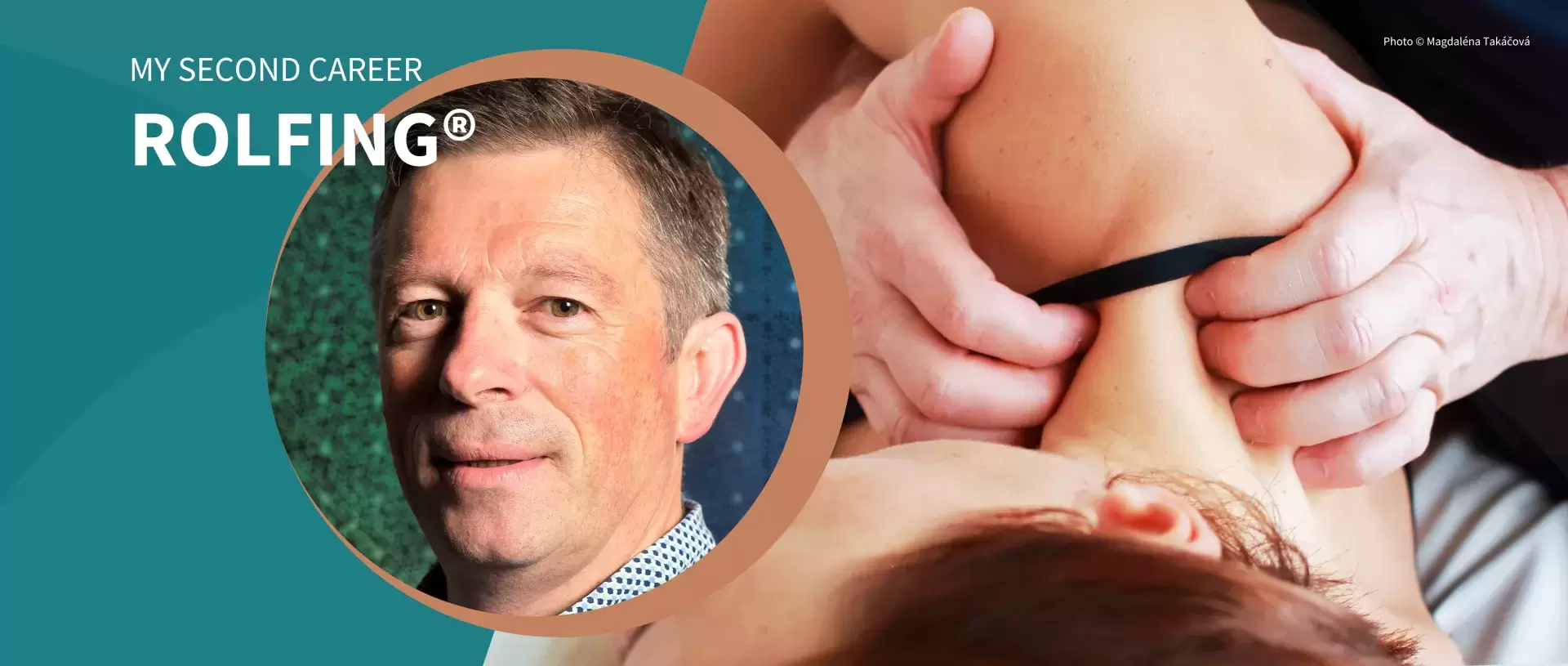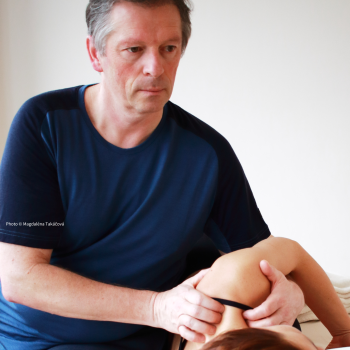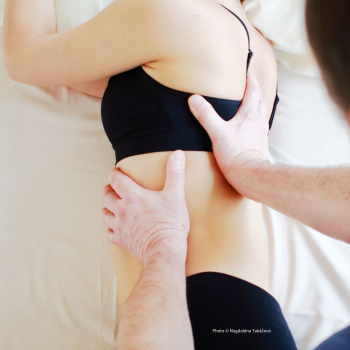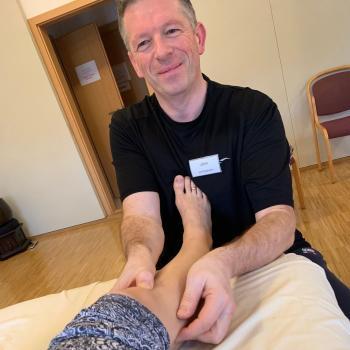By John van Roosmalen
I am a massage therapist. I did my training at the Akademie voor Massage en Beweging in Amsterdam. It is a four-year course, including Western Medicine Fundamentals. I am a career changer, Massage Therapy and Rolfing is my second career. I have been a scientist, a chemist, for 33 years.
As a massagist, what led you to additionally study Rolfing®?
After finishing my massage therapy training, I felt I wasn’t completely ready to start my own practice. I didn’t feel self-secured and competent enough. That basically has to do with my age (55 at the time) and the large discrepancy between my old and new profession. The massage therapy education contained several aspects, including classical massage, relaxation massage, movement education, fascia bodywork, and therapeutical skills.
My biggest interest and enthusiasm were in the fascia bodywork teaching. One of the teachers was a Rolfer®, that’s how I encountered Rolfing.
I decided to do Spectrum Rolfing [now “Level 1”] and after that I was hooked and decided to study Rolfing. After completion, I quit my old job and started my own practice, Rolfing Alkmaar – Ruimte en Stabiliteit, although there were some delays due to Covid-19.
How do your Rolfing skills help you when working on clients?
As a Rolfer, I don’t work on clients, I work with clients. Although I have developed a broad spectrum of services in my practice, including scarwork and oncology massage, the largest part of my clients come for Rolfing sessions. Rolfing has refined my touch and I work on more levels of tissue and holism. That also has to do with gaining more experience and really all trainings I followed added something to my understanding and skills. And it is true, we learn most from our clients. The fascia bodywork we learned in massage therapy education was mainly oriented to the larger muscle groups and their fascia connections.
Now, I work on all fascia layers, from skin to bones, from muscles to viscera. The Rolfing 10 series has proven to be very valuable to achieve major changes, one could say transformations, for my clients.
The understanding of how gravity and habits impact the body and integration through all body systems are also important components, as well as holism, body, mind, emotions, environment, they are all important to include and take into account.
Where do you see similarities between massage and Rolfing Structural Integration? What is different?
Both massage therapy and Rolfing have the intention to support clients in their life, to help them cope with the difficulties they encounter, with mainly the body as entry point and the area of work.
In Rolfing, client education is an important aspect, so that the results are permanent, or better, to set the client on a path to self-care, through sensing the core and tapping into the innate ability of the body to be upright in the field of gravity.
When I was in massage therapy school, I could not imagine working without an intermediate fluid, massage oil or lubricant. Now, when Rolfing, I hardly ever use it. Without it, it’s easier to sense details and sink into the appropriate depth into the structure and treat the fascia. However, I still very much like to give a relaxation or stress-reduction massage as well, using massage oil. It’s a different experience for the client and for the therapist as well.
One of the strong aspects of my massage therapy education was the teaching of therapeutic skills. This is not only very valuable in relation with clients, but it was also important for my personal growth and transformational for myself.
One of the strongest realisations however, I had in Phase II of the Rolfing training receiving the 10-series in class: I had a strong feeling of integration, integrating all discoveries of the previous years into a strong body image. I still carry that with me and build upon it.
How can a massagist profit from taking part at Myofascial Foundation courses (Movement, Anatomy, Touch), even if he or she does not plan to go all the way to become a Certified Rolfer?
My first encounter was in a two-week Spectrum Rolfing course, so prior to stepping into the Rolfing training.
I wondered, as a massage therapist, what I would learn. Big was my surprise that another world opened for me.
Learning Structural Integration and starting to think as a Rolfer is really different from massage therapy. All the parts, Movement, Anatomy, and Touch, will add to the knowledge and skills of the participants that they can apply in their practices, even if not pursuing the full path of becoming a certified Rolfer. Also, all parts add to and strengthen each other. The Anatomy taught is specifically oriented towards Rolfing, towards fascia. Touch and Movement, including embodiments, strengthen each other in client awareness and somatic education.
Are you still working in both professions? How can you combine the two?
I love the mix of bodywork modalities I am offering in my practice, Rolfing, Massage therapy, Oncology massage, ScarWork, and relaxation massage, being able to serve a variety of clients with a variety of questions and issues.
It is very rewarding, enriching and humbling. Rolfing is the largest part of my work. I should also say that I cannot split the individual teachings, they are integrated in me, my clients get me, with all my abilities and limitations. So, often, I mix in massage therapy and scar work in Rolfing sessions, Rolfing based fascia work in oncology massage, etc. For me the fun is in combining and in the width.
What had originally made you give up your career as a scientist and become a bodyworker?
There are both positive and negative aspect about this decision. The negative one is that as I scientist in my previous job, I didn’t see a perspective of personal growth ahead. Being just over fifty, I didn’t want to spend the rest of my professional life feeling like a repetitive bore. And I was mainly working with and in my head.
The funny thing is that because of my massage therapy education - I did my 4-year massage therapy education parallel to my job as a scientist – I started to change. I became more empathetic and more oriented towards cooperation; I started using my head and my heart. The project I coordinated in the last years was one of the most successful ones of my career and it brought me beautiful professional friendships. Abandoning them was the hardest part and what I miss most.
However, the die was cast, it was time for me to go, finally, after working as a scientist for over thirty years. Thankfully, my new path also brings new cooperations and friendships.
Another driver for my decision was that I want to help, and I want to contribute to make the world a better place.
As a scientist, I mainly worked on technology, more specifically on solar energy, and we have come very far since I started working on that in 1993. However, more and more, I realized that it is essential that we also work on our humanity. That facilitated my decision to switch from working on technology to working with people.
As it is often put, being in line with and sensing one’s own body, one’s existence, oneself, it’s harder to bring harm to others and to the planet. When at ease, it’s easier to invite others to feel at ease.
How do you feel with this decision now?
As a bodyworker, I can help and contribute, and work with head, heart, body, and spirit. That feels very complete and satisfying.
One of my main strengths as a scientist was to find solutions for complicated problems. As a Rolfer, I find that this quality of the head (also involving now intuition and touch) helps me find solutions for the often-complex issues that my clients are dealing with, so the scientist in me is not lost. And there are still things, ideas, that I have learned and discovered on my path as a human (including being a scientist), that I want to contribute.
For that, I need to be in touch with my head, heart, body, and spirit, and that’s what Rolfing brings me. I feel it’s important to keep challenging oneself on all aspects of life. For sure, our bodies change all the time.
Author: Certified Rolfer® John van Roosmalen – Netherlands
Editing: Sabine Becker
Photos: Magdaléna Takáčová and private photos supplied by John van Roosmalen
Visit John van Roosmalen’s website
Did you know?
Rolfing training is now coming to the Netherlands. Check out the course dates and register here.
More information on how to become a Certified Rolfer®.
Learn more about Rolfing.
Find a Rolfer near you.
Want to know more?
Sign up for our newsletter and receive regular information about Rolfing® Structural Integration.










